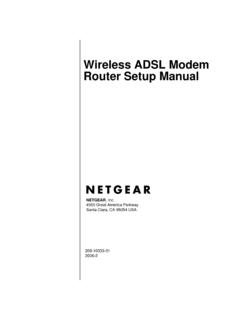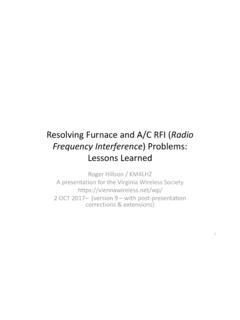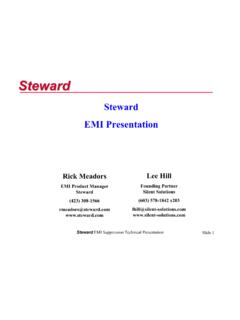Transcription of 2695 troubleshooting guide - LabX
1 Waters Corporation Waters 2690/5 USER & troubleshooting guide 2 Contents 2690/5 Theory Setup procedures. troubleshooting the 2690/5 User maintenance of the 2690/5 Spare Parts 3 2690/5 Theory 2690/5 Solvent Management Flow Path 4 2690/5 Theory 2690/5 Solvent Management Delivery Theory The solvent management system components work together to deliver solvent in the following sequence. 1. The accumulator plunger (left plunger) moves forward delivering solvent, while the primary plunger (right plunger) moves backwards filling with solvent. 2. While the accumulator continues to deliver solvent, the primary plunger waits. The primary pressure transducer then measures the pressure and matches it to the system pressure by moving the primary plunger forward, pre-compressing the solvent. 3. When the accumulator plunger reaches the end of its stroke, it slows down and reverses direction. Simultaneously, the primary plunger moves forward delivering solvent.
2 4. While the accumulator plunger moves backwards, the primary plunger moves forward slightly faster which allows the primary plunger stroke to both fill the accumulator piston chamber and to deliver solvent to the rest of the system This sequence enables the solvent management system to maintain a consistent and pulse-free manner. 5 2690/5 Theory 2690/5 Sample Management System Theory 2690/5 Injection Cycle The injection cycle is completed in three steps. 1. Isolation of the loop. Valve 1 closes. Needle wash pump turns on. Valve 4 opens. Needle moves into the bottom seal. Valve 3,2 open venting the loop to atmospheric pressure. 2. Sample withdrawal. Valve 3 closes Needle wash pump turns off. Valve 4 closes. Needle moves into the vial. Syringe moves withdrawing sample. Needle moves to the bottom seal. 3. Sample injection. Valve 3 opens. Valve 2 closes. Needle moves into the stream. Valve 1 opens. Sample is injected. Syringe moves home. Valve 3 closes 6 2690/5 Theory 2690/5 Sample Management System Purge & Compression Check The purge cycle consists of three parts.
3 1. Purge: Fills the sample loop with new composition of mobile phase replacing the previous mobile phase and any air bubbles. 2. Flush syringe: Fills the syringe with new composition of mobile phase replacing the previous mobile phase and any air bubbles. 3. Compression check: The mobile phase in the injector assembly is compressed to check for leaks, the presence of air bubbles and undegassed mobile phase. 7 SETUP PROCEDURES Priming a New or Dry system using undegassed solvents 1. Fill the solvent bottles with Mobile Phase. 2. From the Status Page turn the degasser on. * 3. Perform a dry prime until solvent flows from each of the four lines. 4. Starting with the organic solvent, perform a 3 minute Wet Prime on each line separately at a flow rate of mL/min ** 5. Once all lines are primed, set the flow rate to 0mL/min with the degasser on for 2 minutes. 6. Start the flow with the initial conditions of your chromatographic method.
4 Equilibrate with 10 column volumes of solvent. 7. Check the Pressure Ripple on page two of the Status Page. The ripple should be less than 2% of the system pressure. (For system pressures above 1000psi, repeat Wet Prime if the ripple is too high) 8. After the column is equilibrated, Purge the autosampler. (initial conditions) 9. Run samples. Priming an idle system using existing mobile phase 1. From the Status Page turn the degasser on. * 2. For each line that will be used, starting with the organic solvent, perform a minute Wet Prime at a flow rate of mL/min. ** 3. Once all lines are primed, set flow rate to 0mL/min with degasser on for 2 minutes. 4. Start the flow with the initial conditions of your chromatographic method. Equilibrate with 10 column volumes of solvent. 5. Check the Pressure Ripple on page two of the Status Page. The ripple should be less than 2% of the system pressure. (for system pressures above 1000psi, repeat Wet Prime if the ripple is too high) 6.
5 After the column is equilibrated, Purge the autosampler. (initial conditions) 7. Run Samples. 8 SETUP PROCEDURES Priming an idle system changing the mobile phase 1. Fill all of the solvent bottles with mobile phase. 2. For each line that will be used, starting with the organic solvent, perform a 3 minute Wet Prime at a flow rate of mL/min. ** 3. Once all of the lines are primed, set the flow rate to 0 mL/min with the degasser on for 2 minutes. 4. Start the flow with the initial conditions of your chromatographic method. Equilibrate with 10 column volumes of solvent. 5. Check the Pressure Ripple on page two of the Status Page. The ripple should be less than 2% of the system pressure. (for system pressures above 1000psi, repeat wet prime if the pressure is too high) 6. After the column is equilibrated, Purge the autosampler. (initial conditions) 7. Run Samples. Replacing the Needle Wash Frit (as needed or 6 months) Remove all carousels and power off the 2690/5.
6 Reach into the sample compartment and unscrew the lower frit retainer which located under the injector assembly. Remove the frit with a small diameter pick and discard. Wet the replacement frit with methanol and seat it completely within the retainer. Reinstall the lower retainer using a clockwise motion. Screw the retainer in by hand until it is firmly seated. * The degasser should never be left on with no flow for long periods of time. ( overnight) ** Caution: To avoid precipitating salts in the Separations Module use an intermediate solvent such as water when you change from buffers to high-organic content solvents. The volume of each solvent line including the vacuum degasser chamber is 7 .5 mL. This volume must be considered when priming the system and changing to a different mobile phase. The degasser can be turned off, the flow rate stopped and the lamp turned off (if controlling the detector through the Alliance) in a Shutdown Method. 9 SETUP PROCEDURES Priming the Seal Wash Pump (when needed) 1.
7 Press the Diag screen key in the Main screen. The Diagnostic screen appears. 2. Attach the syringe adapter (from the Startup Kit) to the syringe. 3. Remove the solvent filter from the plunger seal wash inlet line or remove the plunger seal wash waste line from the waste container. (Either pushing solvent through it or drawing solvent through it can be used to prime the plunger seal wash pump.) 4. Fill the syringe with the plunger seal wash solvent* and attach the syringe adapter to the end of the plunger seal wash line or attach the syringe to the end of the plunger seal wash waste line. 5. Press the Prime Sealwash Screen key and then press the Start screen key. The plunger seal wash procedure begins. Push on the syringe to push seal wash solution through the system or draw on the syringe to pull solvent through the plunger seal wash pump. 6. When solvent flows out of the plunger seal wash line or into the syringe (the pump will run quieter when it is primed) press the Halt screen key.
8 7. Reinstall the solvent filter and place the seal wash inlet line back into the plunger seal wash reservoir or place the plunger seal wash waste line back into the waste container. To finish the priming push the Start screen key again. 8. Press Close to return to the diagnostics screen. * Choose a Seal Wash solution that has high solubility with salts and/or buffers used in the mobile phase. (Usually a solution of 80-90% aqueous, 20-10% methanol.) Priming the Needle Wash Pump (daily or weekly) 1. Make sure Needle Wash line (Green Line) is in its appropriate bottle. 2. Press the Diag screen key in the Main screen. The Diagnostics screen appears. 3. Press the Prime NdlWsh screen key. The 30-second needle wash procedure begins. If solvent does not flow out of the waste line (the yellow line) press the Start Again screen key. * Choose a Needle Wash solution that your sample is soluble in. Buffered solutions or a mobile phase modifier such as TFA are not recommended.
9 If these solutions are necessary they must be flushed from the instrument. 10 TROUBLE SHOOTING THE 2690/5 2690/5 System Error Messages MESSAGE ACTION STEPS Accumulator over pressure Locate guard column / column / inline filter / blocked tubing. Bubble found on intake Wet prime and allow system to sit at zero flow with the degasser in continuous mode for approx. 10 min. prior to starting the run. If the flow rate is greater than 1 mL/min. install extended flow inlet tube. Carousel malfunction Cycle power. If message persists call Waters Service Representative. Carousel Z axis malfunction Cycle power. If message persists call Waters Service Representative. Compression check failed Solvent not degassed properly. Check for bubble on syringe plunger. Test seal pack and valve 3. Perform appropriate maintenance. Degasser pressure fault Replace faulty degasser chamber or vacuum pump. Call Waters Service Representative. Lost prime Solvent not degassed properly.
10 Change check valves. If the flow rate is greater than 1 ml/min. install extended flow inlet tube. Missing vial The missing vial should be placed in the correct location in the tray. Disable the vial sensor [Main>>Config>>Highlight] Verify vial presence" press clear. Call Waters Service Representative. Needle malfunction Check needle wash reservoir. Prime needle wash. Cycle power. If message persists call Waters Service Representative. Plunger homing fault Cycle power. Change inline filter. If message persists call Waters Service Representative. Primary transducer range (volts) Call Waters Service Representative. Sample 11 TROUBLE SHOOTING THE 2690/5 2690/5 System Error Messages MESSAGE ACTION STEPS Solvent delivery h/w fault Cycle power. If message persists call Waters Service Representative. Solvent delivery motor lost sync Cycle power. Change inline filter. If message persists call Waters Service Representative. Syringe Movement malfunction Cycle power.











